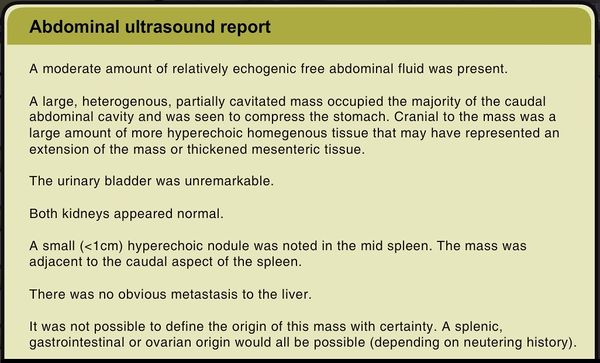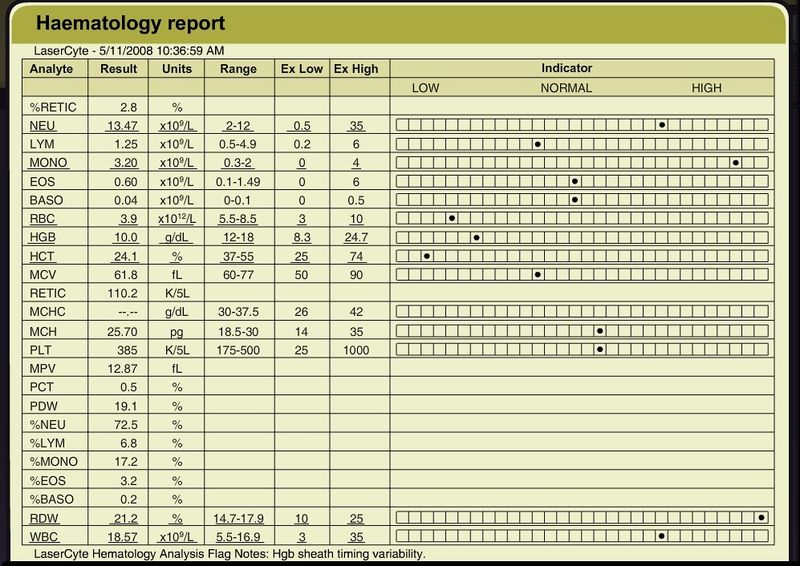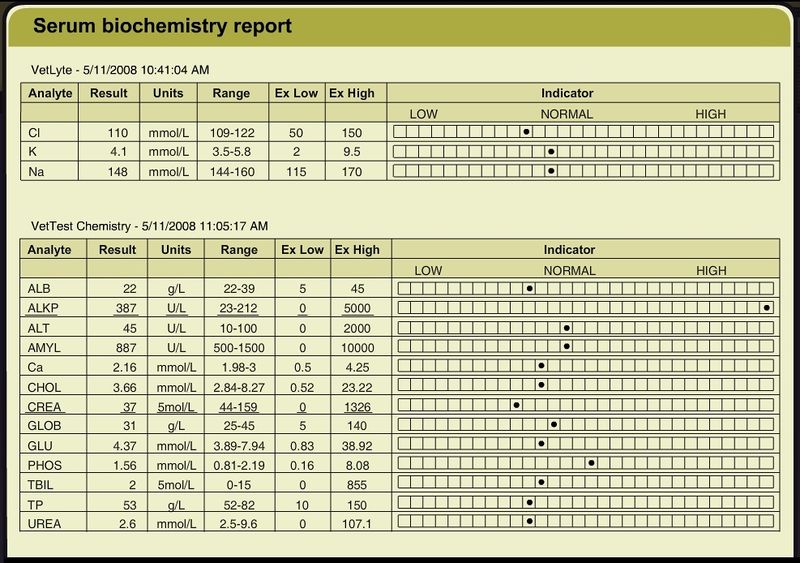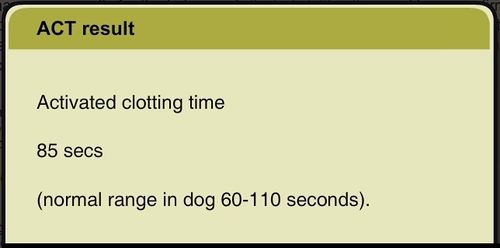|
|
| (13 intermediate revisions by the same user not shown) |
| Line 6: |
Line 6: |
| | :abdominal enlargement, lethargy, inappetance for 3 months. Your physical exam shows an obviously distended abdomen with a very large (>10 cm diameter) firm palpable abdominal mass, mucous membranes pink but paler than normal, periodontal disease. Otherwise clinical exam within normal limits, and she seems surprisingly alert and responsive. The clients say the abdominal enlargement has only happened in the past month. | | :abdominal enlargement, lethargy, inappetance for 3 months. Your physical exam shows an obviously distended abdomen with a very large (>10 cm diameter) firm palpable abdominal mass, mucous membranes pink but paler than normal, periodontal disease. Otherwise clinical exam within normal limits, and she seems surprisingly alert and responsive. The clients say the abdominal enlargement has only happened in the past month. |
| | </big></b> | | </big></b> |
| | + | |
| | + | |
| | + | |
| | + | <center><WikiQuiz |
| | + | questionnumber="100" |
| | + | question="" |
| | + | choice1="" |
| | + | choice2="" |
| | + | choice3="" |
| | + | choice4="" |
| | + | choice5="" |
| | + | correctchoice="4" |
| | + | feedback1="" |
| | + | feedback2="" |
| | + | feedback3="" |
| | + | feedback4="" |
| | + | feedback5="" |
| | + | image= ""> |
| | + | </WikiQuiz></center> |
| | + | |
| | | | |
| | <center><WikiQuiz | | <center><WikiQuiz |
| Line 123: |
Line 143: |
| | |} | | |} |
| | {| class="mw-collapsible mw-collapsed wikitable" | | {| class="mw-collapsible mw-collapsed wikitable" |
| − | ! ||Anaesthetic considerations | + | ! ||Blood donor qualities |
| | |- | | |- |
| | | a) ||Tilting the patient so that the head is slightly higher than the abdomen to allow the mass to fall away from the chest and enable adequate chest expansion | | | a) ||Tilting the patient so that the head is slightly higher than the abdomen to allow the mass to fall away from the chest and enable adequate chest expansion |
| Line 152: |
Line 172: |
| | feedback4="Correct, but there are other considerations. Choose again." | | feedback4="Correct, but there are other considerations. Choose again." |
| | feedback5="Correct, but there are other considerations. Choose again." | | feedback5="Correct, but there are other considerations. Choose again." |
| − | image= "File:Case 22 IMG 0004 1.JPG">
| |
| − | </WikiQuiz></center>
| |
| − |
| |
| − | <center><WikiQuiz
| |
| − | questionnumber="6"
| |
| − | question="You perform the surgery and fortunately it is a splenic mass rather than a huge liver mass. The mass is not ruptured and is removed via splenectomy. The abdomen is closed, she recovers remarkably well and is eating ravenously for the first time in months a few hours after surgery. What is the two-thirds rule of splenic masses?"
| |
| − | choice1="Two-thirds are benign and one-third are malignant. Haemangiosarcoma make up two-thirds of the malignant types "
| |
| − | choice2="Two-thirds are malignant and one-third are benign. Haemangiosarcoma make up one-third of the malignant types "
| |
| − | choice3="Two-thirds are malignant and one-third are benign. Haemangiosarcoma make up two-thirds of the malignant types "
| |
| − | choice4="Two-thirds are malignant and one-third are benign. Histiocytic tumours make up two-thirds of the malignant types "
| |
| − | choice5=""
| |
| − | correctchoice="3"
| |
| − | feedback1="'''Incorrect'''. Choose again."
| |
| − | feedback2="'''Incorrect'''. Choose again."
| |
| − | feedback3="'''Correct'''."
| |
| − | feedback4="'''Incorrect'''. Choose again."
| |
| − | feedback5=""
| |
| − | image= "File:Case 22 IMG 0009.JPG">
| |
| − | </WikiQuiz></center>
| |
| − |
| |
| − | <center><WikiQuiz
| |
| − | questionnumber="7"
| |
| − | question="If this splenic mass was a haemangiosarcoma and had ruptured, what stage would it be and why?"
| |
| − | choice1="Stage I: whether the spleen is ruptured does not influence the staging "
| |
| − | choice2="Stage I, because the spleen has ruptured "
| |
| − | choice3="Stage II, because the spleen has ruptured "
| |
| − | choice4="Stage II, because it was very large "
| |
| − | choice5="Stage III, because it was very large"
| |
| − | correctchoice="3"
| |
| − | feedback1="'''Incorrect'''. Choose again."
| |
| − | feedback2="'''Incorrect'''. Choose again."
| |
| − | feedback3="'''Correct'''."
| |
| − | feedback4="'''Incorrect'''. Choose again."
| |
| − | feedback5="'''Incorrect'''. Choose again."
| |
| − | image= "File:Case 22 IMG 0006.JPG">
| |
| − | </WikiQuiz></center>
| |
| − |
| |
| − | <center><WikiQuiz
| |
| − | questionnumber="8"
| |
| − | question="If the tumour was found at surgery to be a massive liver tumour (isolated to one lobe, usually low-grade hepatocellular carcinoma), what is the prognosis with complete surgical resection?"
| |
| − | choice1="One-year median survival time with 50% recurrence "
| |
| − | choice2="Two years’ median survival time with 10% recurrence "
| |
| − | choice3="Three years’ median survival time with 5% recurrence"
| |
| − | choice4=""
| |
| − | choice5=""
| |
| − | correctchoice="3"
| |
| − | feedback1="'''Incorrect'''. Choose again."
| |
| − | feedback2="'''Incorrect'''. Choose again."
| |
| − | feedback3="'''Correct'''."
| |
| − | feedback4=""
| |
| − | feedback5=""
| |
| − | image= "">
| |
| − | </WikiQuiz></center>
| |
| − |
| |
| − | <center><WikiQuiz
| |
| − | questionnumber="9"
| |
| − | question="If the mass was found to be a massive liver tumour, what piece of surgical equipment could prove most invaluable?"
| |
| − | choice1="Thoracoabdominal (TA) surgical stapling device "
| |
| − | choice2="Electrocautery"
| |
| − | choice3="Haemostatic sponge (Gelfoam® or similar)"
| |
| − | choice4="Surgical suction "
| |
| − | choice5=""
| |
| − | correctchoice="1"
| |
| − | feedback1="'''Correct'''. This is the most useful options, which can prove invaluable for liver lobectomies. It is also useful for lung lobectomies."
| |
| − | feedback2="'''Incorrect'''. This is useful for haemostasis, but not as useful as a surgical stapling device. Choose again."
| |
| − | feedback3="'''Incorrect'''. This is useful for haemostasis, but not as useful as a surgical stapling device. Choose again."
| |
| − | feedback4="'''Incorrect'''. This is an essential tool for oncological abdominal surgery, but not as useful as a surgical stapling device. Choose again."
| |
| − | feedback5=""
| |
| − | image= "">
| |
| − | </WikiQuiz></center>
| |
| − |
| |
| − | <center><WikiQuiz
| |
| − | questionnumber="10"
| |
| − | question="Your patient is now in recovery and sleeping well. Your client wants to take her home immediately. Why does this patient still need close monitoring and what piece of equipment is essential for this postoperative patient?"
| |
| − | choice1="Removal of such a large tumour will result in an internal seroma so she needs to be connected to a suction device to draw off excessive fluid from the abdomen"
| |
| − | choice2="Cardiac arrhythmias are common after splenic surgery and she should be connected to an electrocardiograph to monitor her heart"
| |
| − | choice3="A large splenic mass can cause compression of the lungs by squashing the diaphragm, making her hypoxic, so a blood gas is required every 4 hours after surgery "
| |
| − | choice4="A large splenic mass may result in compression of the urinary bladder and lead to acute renal failure. She needs an indwelling urinary catheter to monitor urine production"
| |
| − | choice5=""
| |
| − | correctchoice="2"
| |
| − | feedback1="'''Incorrect'''. Choose again."
| |
| − | feedback2="'''Correct'''."
| |
| − | feedback3="'''Incorrect'''. Choose again."
| |
| − | feedback4="'''Incorrect'''. Choose again."
| |
| − | feedback5=""
| |
| − | image= "">
| |
| − | </WikiQuiz></center>
| |
| − |
| |
| − | <center><WikiQuiz
| |
| − | questionnumber="11"
| |
| − | question="You monitor the electrocardiograph and notice she has developed a significant arrhythmia. What is the commonest arrhythmia seen in canine patients after splenic surgery?"
| |
| − | choice1="Atrial fibrillation "
| |
| − | choice2="Supraventricular tachycardia "
| |
| − | choice3="Increased vagal tone resulting in bradycardia "
| |
| − | choice4="Ventricular premature contractions "
| |
| − | choice5="Asystole"
| |
| − | correctchoice="4"
| |
| − | feedback1="'''Incorrect'''. Choose again."
| |
| − | feedback2="'''Incorrect'''. Choose again."
| |
| − | feedback3="'''Incorrect'''. Choose again."
| |
| − | feedback4="'''Correct'''."
| |
| − | feedback5="'''Incorrect'''. Choose again."
| |
| − | image= "">
| |
| − | </WikiQuiz></center>
| |
| − |
| |
| − | <center><WikiQuiz
| |
| − | questionnumber="12"
| |
| − | question="How would you manage your patient’s arrhythmia?"
| |
| − | choice1="Lidocaine"
| |
| − | choice2="Procainamide"
| |
| − | choice3="Beta-blocker"
| |
| − | choice4="Angiotensin-converting enzyme (ACE) inhibitor"
| |
| − | choice5="Pimobendan"
| |
| − | correctchoice="1"
| |
| − | feedback1="'''Correct'''."
| |
| − | feedback2="'''Incorrect'''. There is a better drug choice. Choose again."
| |
| − | feedback3="'''Incorrect'''. You selected the wrong drug and your patient did not respond to treatment. Choose again."
| |
| − | feedback4="'''Incorrect'''. You selected the wrong drug and your patient did not respond to treatment. Choose again."
| |
| − | feedback5="'''Incorrect'''. You selected the wrong drug and your patient did not respond to treatment. Choose again."
| |
| − | image= "">
| |
| − | </WikiQuiz></center>
| |
| − |
| |
| − | {| class="mw-collapsible mw-collapsed wikitable"
| |
| − | ! Histopathology Report
| |
| − | |-
| |
| − | | [[File:Case 22 histopathology.jpg]]
| |
| − | |}
| |
| − |
| |
| − | <center><WikiQuiz
| |
| − | questionnumber="13"
| |
| − | question="You send samples of the mass off to histopathology. Now that you have the results of histology, what do you do next?"
| |
| − | choice1="Advise she should receive adjuvant doxorubicin chemotherapy as the next step, to begin once the wound has healed. You also advise regular follow-ups for 12 months after surgery."
| |
| − | choice2="Offer nothing further as therapy and advise a recheck in 10−14 days for suture removal, then further rechecks every 3−6 months for 12 months after surgery."
| |
| − | choice3="Advise the clients that this kind of tumour is reported to occur infrequently as a splenic mass. However the prognosis is expected to be good with surgery alone, with a low metastatic rate. Adjuvant doxorubicin chemotherapy could be considered the more aggressive next step. This may be beneficial but data to prove this conclusively are lacking. A valid option is no further therapy as the surgery is potentially curative. Removing such a large abdominal mass is a strongly palliative option. Schedule a recheck in 10−14 days for suture removal, then further rechecks every 3−6 months for 12 months after surgery."
| |
| − | choice4=""
| |
| − | choice5=""
| |
| − | correctchoice="3"
| |
| − | feedback1="'''Incorrect'''. You should discuss with the clients that chemotherapy may be of use to extend survival time, but this has not been proven. Strongly recommending adjuvant chemotherapy without sufficient data to support its benefit is controversial. Choose again."
| |
| − | feedback2="'''Incorrect'''. There is insufficient evidence to exclude or include adjuvant chemotherapy as part of the treatment options for this kind of tumour. You should give the clients the option of considering adjuvant chemotherapy. Choose again."
| |
| − | feedback3="'''Correct'''. This is the option that allows the clients to make their own decision knowing all the current information."
| |
| − | feedback4=""
| |
| − | feedback5=""
| |
| − | image= "">
| |
| − | </WikiQuiz></center>
| |
| − |
| |
| − | <center><WikiQuiz
| |
| − | questionnumber="14"
| |
| − | question="With respect to other splenic masses seen in dogs, what do we understand by the term ‘nodular fibrohistiocytic proliferation’?"
| |
| − | choice1="This is another name for nodular hyperplasia "
| |
| − | choice2="These nodules have characteristics of splenic lymphoid hyperplasia and malignant splenic stromal tumours "
| |
| − | choice3="This is another name for histiocytic sarcoma "
| |
| − | choice4="These nodules are characterized by malignant lymphoid cells "
| |
| − | choice5="These nodules are characterized by high ratios of benign lymphoid cells and aggressive mesenchymal cells "
| |
| − | correctchoice="2"
| |
| − | feedback1="'''Incorrect'''. Choose again."
| |
| − | feedback2="'''Correct'''."
| |
| − | feedback3="'''Incorrect'''. Choose again."
| |
| − | feedback4="'''Incorrect'''. Choose again."
| |
| − | feedback5="'''Incorrect'''. Choose again."
| |
| | image= ""> | | image= ""> |
| | </WikiQuiz></center> | | </WikiQuiz></center> |
| | | | |
| − | <center><WikiQuiz
| |
| − | questionnumber="15"
| |
| − | question="Infiltrative disease of the spleen, e.g. lymphoma or metastatic mast cell tumour, can appear ultrasonographically like what non-neoplastic condition affecting the spleen?"
| |
| − | choice1="Extramedullary haematopoiesis "
| |
| − | choice2="Splenic infarct "
| |
| − | choice3="Splenic torsion "
| |
| − | choice4="Splenitis"
| |
| − | choice5=""
| |
| − | correctchoice="4"
| |
| − | feedback1="'''Incorrect'''. Choose again."
| |
| − | feedback2="'''Incorrect'''. Choose again."
| |
| − | feedback3="'''Incorrect'''. Choose again."
| |
| − | feedback4="'''Correct'''."
| |
| − | feedback5=""
| |
| − | image= "">
| |
| − | </WikiQuiz></center>
| |
| − |
| |
| − | <center><WikiQuiz
| |
| − | questionnumber="16"
| |
| − | question="What are the most common tumours seen in the spleen of cats?"
| |
| − | choice1="Lymphoma: haemangiosarcoma "
| |
| − | choice2="Mast cell tumour: haemangiosarcoma "
| |
| − | choice3="Lymphoma: mast cell tumour "
| |
| − | choice4="Haemangiosarcoma: liposarcoma "
| |
| − | choice5="Histiocytic sarcoma: mast cell tumour "
| |
| − | correctchoice="3"
| |
| − | feedback1="'''Incorrect'''. Choose again."
| |
| − | feedback2="'''Incorrect'''. Choose again."
| |
| − | feedback3="'''Correct'''."
| |
| − | feedback4="'''Incorrect'''. Choose again."
| |
| − | feedback5="'''Incorrect'''. Choose again."
| |
| − | image= "">
| |
| − | </WikiQuiz></center>
| |
| − |
| |
| − | <center><WikiQuiz
| |
| − | questionnumber="17"
| |
| − | question="In cats, what is the treatment of choice for splenic mast cell tumour and what is the prognosis with treatment?"
| |
| − | choice1="Splenectomy; poor prognosis"
| |
| − | choice2="Chemotherapy; poor prognosis "
| |
| − | choice3="Splenectomy; good prognosis "
| |
| − | choice4="Chemotherapy; good prognosis "
| |
| − | choice5="No treatment; grave prognosis"
| |
| − | correctchoice="3"
| |
| − | feedback1="'''Incorrect'''. Choose again."
| |
| − | feedback2="'''Incorrect'''. Choose again."
| |
| − | feedback3="'''Correct'''."
| |
| − | feedback4="'''Incorrect'''. Choose again."
| |
| − | feedback5="'''Incorrect'''. Choose again."
| |
| − | image= "">
| |
| − | </WikiQuiz></center>
| |
| − | <br><br>
| |
| − | {{Elsevier
| |
| − | |url = http://www.elsevierhealth.co.uk/product.jsp?isbn=9780702042508
| |
| − | |book = North and Banks, Small Animal Oncology
| |
| − | |image = North and Banks SA Oncology.jpg
| |
| − | }}
| |
| | | | |
| | | | |
| − | [[Category:Case-based Quizzes]] | + | [[Category:Neoplasia]] |





